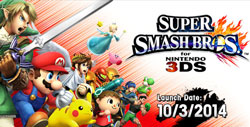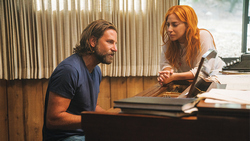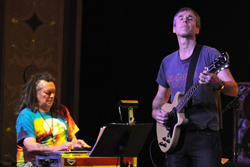On Oct. 3, Nintendo released the fourth entry in its successful, “Super Smash Bros.” series for Nintendo 3DS. For anyone unfamiliar with this name, “Smash” is a fighting game starring characters from Nintendo’s iconic franchises duking it out in frantic four player action until only one is left standing. Players select one of these characters, and using a variety of attacks and special moves, attempt to rack up enough damage to send their opponents flying out of the ring. Characters in this version include famous Nintendo icons such as Mario and Link, non-Nintendo characters such as Mega Man, Pac-Man, and Sonic the Hedgehog and even lesser known Nintendo personas such as Mr. Game & Watch and the Duck Hunt Dog.
This new version offers several first time features aside from new characters. Smash Run allows players to run through environments, defeating enemies and collecting power-ups for their selected character while competing against three other opponents. After five minutes, all fighters are brought together for a final challenge ranging from a timed battle to see who gets the most KO’s, to climbing a tower, to running a race, or anything in between.
Another new mode that takes advantage of the 3DS’s Street Pass function is Street Smash. In this mode, players select a token based on a character they have unlocked and do battle with others in a borderless arena. Each token is moved around the field and rammed into other tokens, attempting to knock them out of the arena until only one remains. Winning grants coins and equipment that can be used in the third new game mode, character customization.
Character customization is by far the strongest addition to the series. By collecting equipment in Smash Run, Classic, or Trophy Rush, the player can apply them to any character and gain benefits to one of three stats, Attack, Defense, or Speed. Typically, equipping something to boost one stat gives a decrease in another stat in a rock-paper-scissors type of relationship. Attacking raising items reduce defense, defense increasing items reduce speed, and speed enhancing items reduce attack. One can even customize the special moves of each fighter based on different versions they’ve collected. Now anyone can take a fighter they like and truly make it their own.
You can even build your own fighter from the ground up in the form of a Mii Fighter. By using digital avatars saved on your 3DS system, you can create a fighter from three distinct archetypes (a hand-to-hand fighter, a swordfighter, or a gunner) and select special moves in the same way as you would a customized fighter. You can even select different outfits to customize your fighter’s appearance and put yourself in the game, literally!
A final new mode added in this version is Trophy Rush. Players spend coins to add time to a clock that allows them to go into a block-smashing mini game. Blocks and bombs fall from the sky, which the player must then break. Each successful break adds points to their score as well as fills up a fever meter. When the fever meter is full, trophies, coins, and occasionally customization parts rain from the sky while the fever meter slowly drains. The player must then fill it up again. However, there are few obstacles the player must overcome. If bombs are not quickly disposed of, they will explode, damaging or possibly KOing players. Players must also keep moving because a bubble will soon fall, dealing damage and potentially knocking them off-screen if they remain stationary too long. Blocks also stack on each other, and allowing them to remain at a certain height for too long will instantly KO the player as the stage falls out from under them. A KO results in a reduction from the remaining time, a small wait as the stage is reset, and the current chain the player has being reset. While it can seem like everything in this mode is trying to KO you, it’s still a fun edition to the series and a great way to stock up on trophies and custom parts.
Along with the new modes, there are several changes between “Smash 3D” and previous versions. One is All-Star mode. All-Star mode is a challenge where players battle all the fighters in the game in a series of matches, with each match having between three and six opponents. Players retain their damage from all previous fights going into later rounds. In between rounds, there is a small rest area with three healing items that the player may use at any time between matches. From time to time, trophies will appear in the rest area that can be collected. Beating All-Star mode nets the player an alternate trophy of the character they used that can only be obtained in this mode.
In previous versions of “Smash Bros.,” All-Star mode matches were divided by series, with all the characters representing a series appearing in one battle. This time, they are grouped by years, with characters debuting in a specific time-span fighting together. Another major difference is the healing items. Previous iterations gave the player three items that would heal all of their damage. In this version, the items heal various degrees of damage, one of which can only be used if they have 100 percent or more. The change to being grouped by year is an interesting decision that I feel adds flavor and a bit of history to a tried and true aspect of the “Smash” series.
 Finally, there is Classic Mode, the staple mode of the series where players fight other characters under various conditions, culminating in a final battle with Master Hand. Players fight everything from standard matches, matches against giant characters, or matches against metal versions of characters. Players win gold after each battle, which can be used to unlock things in other game modes. However, this mode is different from those in the past in several key ways.
Finally, there is Classic Mode, the staple mode of the series where players fight other characters under various conditions, culminating in a final battle with Master Hand. Players fight everything from standard matches, matches against giant characters, or matches against metal versions of characters. Players win gold after each battle, which can be used to unlock things in other game modes. However, this mode is different from those in the past in several key ways.
First, the mode no longer lasts ten stages with each stage being the same each time. Instead, players now choose their own way by selecting from various paths. Each pathway has its difficulty marked by its color, as well as a symbol showing what series the player can expect an opponent from. Coins and occasionally trophies appear on these roads for the player to collect in addition to what they earn from battles. Another new edition is a prize wheel that is spun before each battle and determines what, if any, prize will be given to the player if they win.
Another change to this mode is the difficulty select. In the past, players would select a difficulty and number of lives on the character select screen. Both decisions had five options and lives would have to last the player the entire mode. This time around, players can play a standard difficulty for free, but must pay coins to raise or lower it with rewards for each battle adjusted accordingly. The player can no longer select the number of lives for Classic Mode, but instead is given two lives per stage, with a lost life regenerating each stage. These changes add a new twist to the classic “Smash” game mode that offers players an enhanced opportunity for fun, practice, and riches.
“Smash” for 3DS also offers a robust online mode where players can fight with their friends or anyone in the world. They can play for fun in a variety of matches where no statistics are kept, or play “For Glory,” with stricter rules in which the wins and losses are recorded for everyone to see. Those who don’t want to play can act as a spectator on other matches and bet on winners to get gold that can be spent on trophies and in other game modes.
“Smash 3D” is not without its drawbacks, however. The online mode suffers from loading issues that can cause the action to slow down or even momentarily stop. While it does not render the mode unplayable, it can be quite frustrating to see a loading symbol in the middle of frantic fast-paced four player action. All-Star’s limited selection of healing items offers lower damage recovery than previous versions, and having a required damage limit for one item makes it difficult for players who like to heal at lower damage percentages. In Trophy Rush mode, it can feel like everything is leading to KO, and it is especially irritating when a 100+ chain of blocks is broken because a player didn’t see a bomb.
Acquiring parts for character customization, especially a specific character’s alternate special moves, can be difficult as getting parts in any of the modes is seemingly random, with no way to purchase specific equipment or moves. Also, having to pay coins to alter the difficulty of Classic Mode can be off-putting at first, but the increased rewards are more than worth it. However, the fact that the prize wheel has an option that gives no rewards is especially infuriating when a player has barely defeated Master Hand only to find out their efforts have yielded nothing. The fact that rewards can be hard to come by at times only enhances the consternation of losing rewards every time a player has to use a continue.
Even with these few drawbacks, and the overall frustrating nature of the game at times, “Smash” for 3DS is an incredible buy for people looking for a game with friends, or to just settle who the best fighter in all of Nintendo is. The game is available for purchase at retail and as a digital download. For those who want to try the game, a demo is available in the Nintendo E-Shop as a preview. Now get Smashing!
IMAGES TAKEN from videogamesblogger.com
IMAGES TAKEN from en.wikipedia.com




